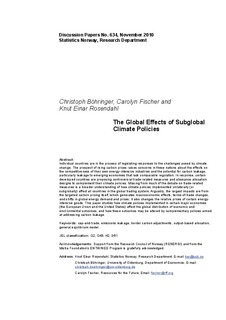| dc.contributor.author | Böhringer, Christoph | |
| dc.contributor.author | Fischer, Carolyn | |
| dc.contributor.author | Rosendahl, Knut Einar | |
| dc.date.accessioned | 2010-11-16T10:29:02Z | |
| dc.date.available | 2010-11-16T10:29:02Z | |
| dc.date.issued | 2010 | |
| dc.identifier.issn | 0809-733X | |
| dc.identifier.uri | http://hdl.handle.net/11250/179901 | |
| dc.description | The article is later published in: The B.E. Journal of Economic Analysis & Policy: Vol. 10: Iss. 2, Article 13, DOI: 10.2202/1935-1682.2583 | en_US |
| dc.description.abstract | Individual countries are in the process of legislating responses to the challenges posed by climate change. The prospect of rising carbon prices raises concerns in these nations about the effects on the competitiveness of their own energy-intensive industries and the potential for carbon leakage, particularly leakage to emerging economies that lack comparable regulation. In response, certain developed countries are proposing controversial trade-related measures and allowance allocation designs to complement their climate policies. Missing from much of the debate on trade-related measures is a broader understanding of how climate policies implemented unilaterally (or subglobally) affect all countries in the global trading system. Arguably, the largest impacts are from the targeted carbon pricing itself, which generates macroeconomic effects, terms-of-trade changes, and shifts in global energy demand and prices; it also changes the relative prices of certain energy-intensive goods. This paper studies how climate policies implemented in certain major economies (the European Union and the United States) affect the global distribution of economic and environmental outcomes, and how these outcomes may be altered by complementary policies aimed at addressing carbon leakage. | en_US |
| dc.description.sponsorship | Support from the Research Council of Norway (RENERGI) and from the Mistra Foundation’s ENTWINED Program is gratefully acknowledged. | en_US |
| dc.language.iso | eng | en_US |
| dc.publisher | Statistics Norway, Research Department | en_US |
| dc.relation.ispartofseries | Discussion Papers;634 | |
| dc.subject | Cap-and-trade | en_US |
| dc.subject | Emissions leakage | en_US |
| dc.subject | Border carbon adjustments | en_US |
| dc.subject | Output-based allocation | en_US |
| dc.subject | General equilibrium model | en_US |
| dc.subject | Climate change | en_US |
| dc.subject | Climate policy | en_US |
| dc.subject | Taxation | en_US |
| dc.subject | Energy | en_US |
| dc.subject | Klima | en_US |
| dc.subject | Klimaendringer | en_US |
| dc.subject | Utslipp | en_US |
| dc.subject | CO2-avgifter | en_US |
| dc.subject | Priser | en_US |
| dc.subject | Politikk | en_US |
| dc.subject | Klimapolitikk | en_US |
| dc.subject | JEL classification: D61 | en_US |
| dc.subject | JEL classification: H2 | en_US |
| dc.subject | JEL classification: Q2 | en_US |
| dc.subject | JEL classification: Q43 | en_US |
| dc.title | The Global Effects of Subglobal Climate Policies | en_US |
| dc.type | Working paper | en_US |
| dc.source.pagenumber | 34 | en_US |
